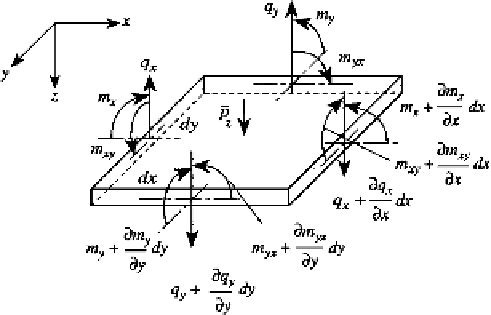Information Technology Reference
In-Depth Information
FIGURE 13.6
Equilibrium element.
Finally, it can be seen that
m
xy
=
m
yx
.
In summary,
∂
x
q
x
+
∂
y
q
y
+
p
z
=
0
∂
x
m
x
+
∂
y
m
yx
−
q
x
=
0
(13.31a)
∂
y
m
y
+
∂
x
m
xy
−
q
y
=
0
m
xy
=
m
yx
or in matrix notation,
m
x
m
y
m
xy
q
x
q
y
∂
x
0
∂
y
−
10
0
0
p
z
0
0
0
=
0
∂
y
∂
x
0
−
1
+
(13.31b)
000
∂
x
∂
y
D
s
s
+
p
=
0
These equations for kinematics, material law, and equilibrium can now be utilized to
develop the plate theories in common use today.
13.3
Classical Plate Theory
Classical plate theory is based on the so-called Kirchhoff assumptions. In this theory, it
is assumed that straight lines, initially normal to the middle surface, remain straight and
undeformed and remain normal to the middle surface as the plate deforms. This implies
that deformations due to transverse shear are neglected. This theory results in tractable
governing equations that are comparable in their usefulness to the engineering beam theory
equations.














Search WWH ::

Custom Search